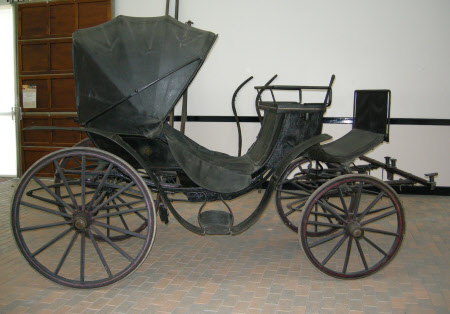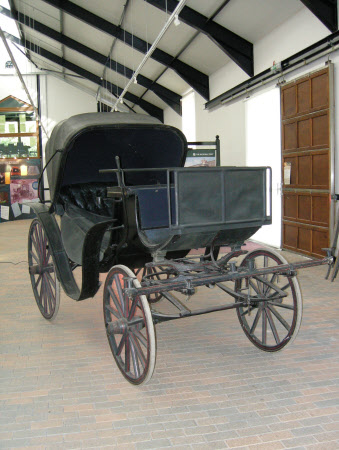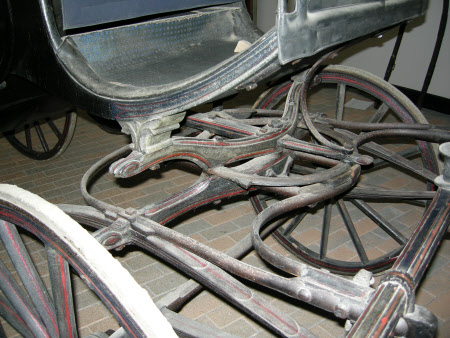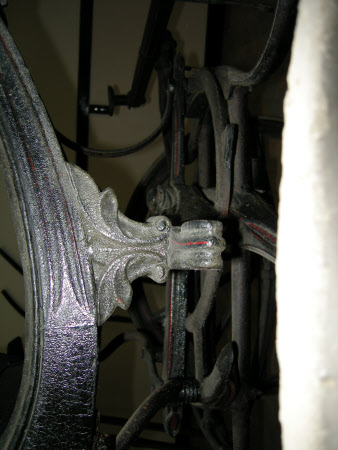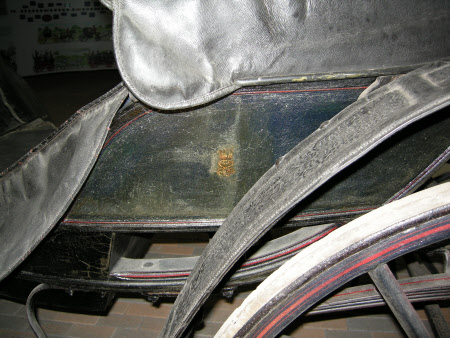Victoria
Richard, Graf von Pfeil
Category
Carriages & other vehicles
Date
1903
Materials
Painted wood body with morocco leather and wool cloth upholstery and four rubber shod wheels.
Measurements
214.5 x 328 x 154.5cm (7ft 1/4in x 10ft 9 1/8in x 5ft 3/4in)
Place of origin
London
Order this imageCollection
National Trust Carriage Museum
NT 272903.1
Caption
Victorias were introduced by the future King Edward VII from Paris and were made popular by the patronage of Queen Victoria who favoured this carriage style. The low access, elegant style and comfortable seating made it very popular with ladies for fine weather use. Most wealthy households had a Victoria and a Brougham. The low sweeping mud guards may well have been designed with large dressed in mind.
Summary
Victoria built for Lord Stanhope by Pfiel Stedall & Son in 1903. Panel Boot Victoria (four wheels) for a pair of horses. The carriage body has skeleton lower quarters and a curved bottom line from back of the body to the footboard and is sprung on full elliptic springs. There is no occasional seat and a fixed heelboard. The coachman’s seat has single seat rails. The lether hood is on single straight joints. The interior trim is of black leather with one leather buttoned cushion and a detachable leather apron. Painted in black livery with red lining and Stanhope cypher on both side and rear panels.
Full description
Victorias are open carriages, driven by a coachman with a footman sitting next to him. The low comfortable body carries two, or occasionally three if it has a folding seat stowed in the back of the boot. The low access, elegant style and comfortable seating made the Victoria very popular with ladies for fine weather use. This carriage was built in the early 1900s by Pfiel Stedall & Son. It was a gift from the Trustees of the Chevening Estate, Kent. It has been fully conserved. Originally this carriage belonged to Lord Stanhope and is painted in his colours. It could be driven to either a single horse, when shafts would be fitted, or a pair, which need a splinter bar and a pole.
Provenance
Property of the late Lord Stanhope
Marks and inscriptions
On the offside side panel.: Stanhope cypher. On nearside side panel.: Stanhope cypher On the rear panel.: Stanhope cypher On front nearside tyre.: “ THE IDEAL TYRE MADE IN AMERICA “ On front offside tyre.: “ THE IDEAL TYRE MADE IN AMERICA “ On rear nearside tyre: “ THE IDEAL TYRE MADE IN AMERICA “ On rear offside tyre.: “ THE IDEAL TYRE MADE IN AMERICA “ On front nearside wheel.: MANUFACTURED FOR PFEIL STEDALL & SON LONDON 1903 W On front offside wheel.: MANUFACTURED FOR PFEIL STEDALL & SON LONDON 1903 W On rear nearside wheel.: MANUFACTURED FOR PFEIL STEDALL & SON LONDON 1903 W On rear offside wheel.: MANUFACTURED FOR PFEIL STEDALL & SON LONDON 1903 W On axle arm : “MANUFACTURED FOR PFEIL STEDALL & SON LONDON 1903 W”
Makers and roles
Richard, Graf von Pfeil, coach builder
